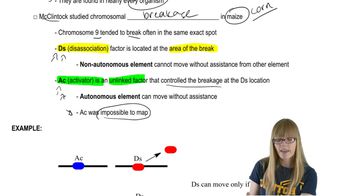Describe the structure of giant polytene chromosomes and how they arise.
Table of contents
- 1. Introduction to Genetics51m
- 2. Mendel's Laws of Inheritance3h 37m
- 3. Extensions to Mendelian Inheritance2h 41m
- 4. Genetic Mapping and Linkage2h 28m
- 5. Genetics of Bacteria and Viruses1h 21m
- 6. Chromosomal Variation1h 48m
- 7. DNA and Chromosome Structure56m
- 8. DNA Replication1h 10m
- 9. Mitosis and Meiosis1h 34m
- 10. Transcription1h 0m
- 11. Translation58m
- 12. Gene Regulation in Prokaryotes1h 19m
- 13. Gene Regulation in Eukaryotes44m
- 14. Genetic Control of Development44m
- 15. Genomes and Genomics1h 50m
- 16. Transposable Elements47m
- 17. Mutation, Repair, and Recombination1h 6m
- 18. Molecular Genetic Tools19m
- 19. Cancer Genetics29m
- 20. Quantitative Genetics1h 26m
- 21. Population Genetics50m
- 22. Evolutionary Genetics29m
7. DNA and Chromosome Structure
Eukaryotic Chromosome Structure
Problem 8
Textbook Question
Describe the sequence of research findings that led to the development of the model of chromatin structure.
 Verified step by step guidance
Verified step by step guidance1
Begin by understanding that early research identified DNA as the genetic material, but the physical form of DNA inside the nucleus was not yet clear. Scientists observed that DNA was associated with proteins, suggesting a complex structure.
Next, study the discovery of nucleosomes, where researchers found that DNA wraps around histone proteins forming bead-like structures. This was a key finding showing the first level of chromatin organization.
Then, explore how electron microscopy and biochemical experiments revealed that nucleosomes are connected by linker DNA, creating a 'beads-on-a-string' structure, which is the primary level of chromatin packing.
After that, examine how further research showed that this string of nucleosomes folds into a more compact 30-nanometer fiber, involving interactions between histone tails and linker DNA, representing a higher-order chromatin structure.
Finally, consider how ongoing studies demonstrated that chromatin can further loop and fold into even more complex structures, allowing DNA to be efficiently packed in the nucleus while still accessible for transcription and replication, leading to the current hierarchical model of chromatin organization.
 Verified video answer for a similar problem:
Verified video answer for a similar problem:This video solution was recommended by our tutors as helpful for the problem above
Video duration:
2mPlay a video:
Was this helpful?
Key Concepts
Here are the essential concepts you must grasp in order to answer the question correctly.
Discovery of DNA and Histones
Early research identified DNA as the genetic material and histones as basic proteins associated with DNA. Understanding that DNA wraps around histones was crucial for recognizing how genetic material is compacted within the nucleus.
Recommended video:
Guided course

Discovery
Nucleosome Model
The nucleosome was discovered as the fundamental unit of chromatin, where DNA is wrapped around a histone octamer. This model explained the first level of DNA packaging and provided insight into chromatin’s repeating structure.
Recommended video:
Guided course

Chromatin
Higher-Order Chromatin Structure
Subsequent research revealed that nucleosomes fold into more complex structures, such as the 30 nm fiber and looped domains, explaining how chromatin achieves further compaction and regulates gene accessibility.
Recommended video:
Guided course

Chromatin
Related Videos
Related Practice
Textbook Question
633
views


